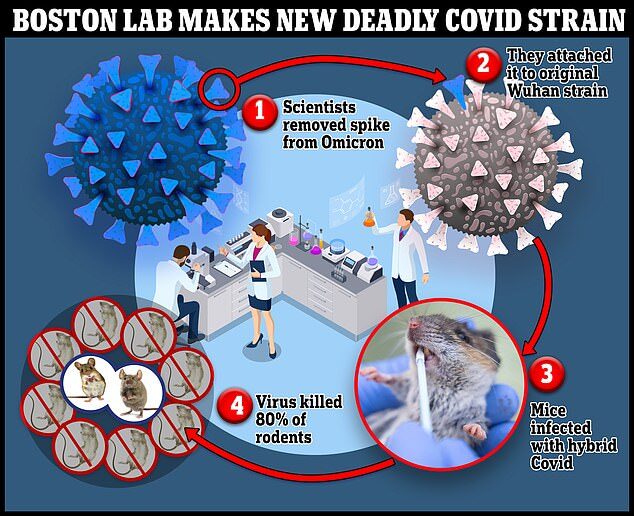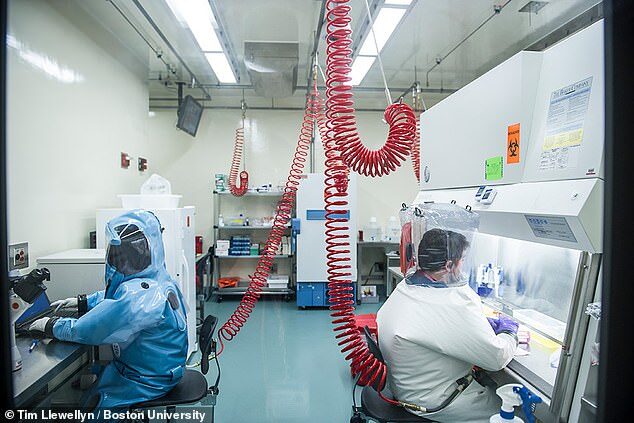
The mutant variant — which is a hybrid of Omicron and the original Wuhan virus — killed 80 percent of mice infected with it at Boston University.
Comment: Indeed experiments on mice and in a laboratory do not necessarily reflect the possibility virulence and mortality of a virus on humans in a real world situation, however what's more concerning is why scientists are being funded to pursue such experiments.
When a similar group of rodents were exposed to the standard Omicron strain, however, they all survived and only experienced 'mild' symptoms.
The scientists also infected human cells with the hybrid variant and found it was five times more infectious than Omicron.
This suggests the man-made virus might be the most contagious form yet.
It will no doubt surprise many Americans that such experiments continue to go on in the US despite concerns similar studies may have led to the global Covid outbreak.
Comment: Americans might be surprised, but the US has the largest bioweapons research program of any country, with laboratories in vassal states across the planet.

Comment: This claim is demonstrably false. Because it has been proven that covid was circulating some time before these allegations, however there was an announcement of a US bioweapons laboratory security leak that also coincides with the timing some of the first discoveries of Covid-19: Compelling Evidence That SARS-CoV-2 Was Man-Made
So-called gain-of-function research involved tinkering with viruses to make them more lethal or infectious - with the hopes of getting ahead of a future outbreak.
Comment: Despite these supposedly altruistic efforts, we've yet to hear of how this highly risky research has prevented or even reduced a serious outbreak.
In the new research, which has not been peer-reviewed, a team of researchers from Boston and Florida extracted Omicron's spike protein — the unique structure that binds to and invades human cells.
It has always been present in the virus but has become more evolved over time. Omicron has dozens of mutations on its spike protein that made it so infectious.
Comment: Scientists warned that vaccinating amidst an outbreak would force the virus to mutate.
Researchers attached Omicron's spike to the original wildtype strain that first emerged in Wuhan at the start of the pandemic.
The researchers looked at how mice fared against the new hybrid strain compared to the original Omicron variant.
Writing in the paper, they said: 'In...mice, while Omicron causes mild, non-fatal infection, the Omicron S-carrying virus inflicts severe disease with a mortality rate of 80 percent.'
The researchers said it signaled that while the spike protein is responsible for infectivity, changes to other parts of its structure determine its deadliness.
The Coronavirus pandemic has prompted a global surge in laboratories that handle dangerous viruses — despite concerns Covid may have been the result of the risky experiments.
More than 40 facilities certified as biosafety level 3 (BSL-3) or BSL-4 have either been built or have gone into construction since 2020, predominantly across Asia.
Comment: 'Across Asia', but funded by whom? Because the coronavirus experiments in Wuhan were funded by US institutions.
Many countries believe they were caught flat-footed by Covid and want to get ahead of the next devastating outbreak by studying pathogens that pose a threat to humans.
Comment: Sweden barely locked down and stood as a testament to how Covid was little more than the flu; moreover it proved how lockdowns were many times more harmful, and deadly, than the virus itself.
Experiments at these labs often involve tinkering with animal viruses to advance treatments and vaccines that could be used in a future outbreak.
But there are widespread concerns that these experiments might actually raise the risk of pandemics — something some experts believe was the case with Covid.
Professor Paul Hunter, an expert in infection diseases at the University of East Anglia in England, told DailyMail.com he was concerned about what all the new labs would be used for.
'The issue is what you're going to be using [the labs] for,' he told this website. 'If they're for diagnostic purposes, then you need them. But I don't think every country needs a BSL-4.'
He added: 'If they start having a dual purpose for research that has offensive military implications, that is the concern.'
Russia has set out its proposals for 15 of the maximum security labs and India is aiming for 18 BSL-3 and BSL-4 labs in total. The US is also adding a further highest level biosecurity lab to its existing 12.
Comment: Note that Russia's are part of a proposal, as are India's, meanwhile the US already actually has 12 up and running. It also has the worst track record in recent history for leaks and sinister experiments on humans.
The scientists also looked at the different strains' effect on human lung cells that were grown in the lab.
Covid latches onto human cells with its spike protein, and instructs healthy cells to produce copies of itself.
The scientists admit the hybrid virus is unlikely to be as deadly in humans as it was in mice.
This is because the specific breed of lab mice used are very susceptible to severe Covid disease. Mice and humans also have very different immune responses to the virus.
The lab, at Boston University's National Emerging Infectious Diseases Laboratories, is one of 13 biosafety level 4 labs in the US.
These are labs that are authorized to handle the most dangerous pathogens. There are also facilities in Texas, Atlanta and Manhattan, Kansas.
In BSL-3 labs, researchers do all experiments in a 'biosafety cabinet' — an enclosed, ventilated workspace for handling materials contaminated with pathogens.
The labs also have self-closing doors, sealed windows, floors and walls, and filtered ventilation systems.
In a BSL-4 lab, full-body, air-supplied pressure suits are worn and workers must change their clothing before entering and shower before leaving.
The lab is situated in a separate section of the building and has its own dedicated air supply.
The 'lab leak' origin theory for Covid was initially dismissed as conspiracy at the start of the pandemic in favour of a natural emergence.
But the hypothesis gained momentum following a series of revelations and cover-ups.
Crucial information about the earliest infected patients was wiped from the Wuhan lab's database in late 2019 and one of its staff vanished after coming down with a mysterious flu-like illness.
Fierce debate about the origins of the Covid pandemic was reignited today after two new studies claimed to trace the outbreak back to a notorious animal slaughter market in Wuhan.
One shows for the first time how the earliest human cases were clustered within a small radius around the Huanan Seafood Market in winter 2019.
Comment: By this point there were cases reported across the planet, not just in Wuhan: Coronavirus emerged in Italy in September 2019 - Italian study
https://www.biorxiv.org/content/10.1101/2022.10.13.512134v1.full.pdf




Comment: See also: Bill Gates renews warnings over 'small pox terror' threat, FDA approved drug in May for disease that was 'eradicated' in 1980